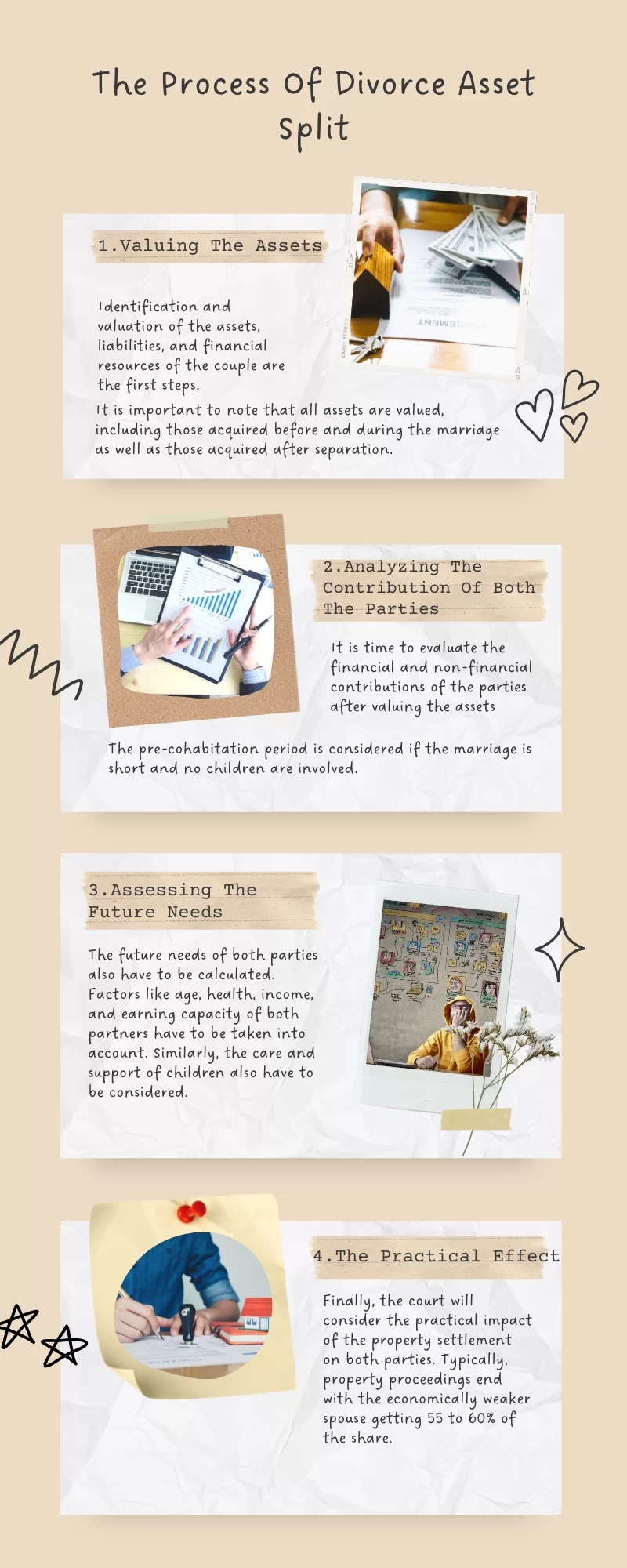The global rate of divorce and separation is on the rise. This can be attributed to various causes and Australia is no exception to the increased rate of divorce.
While divorce often brings emotional challenges, it's crucial to approach the process pragmatically, especially when substantial financial interests are involved.
One important point to note is that you do not need to be divorced in order to have your assets divided. This is a common misconception. You can do your property settlement and split your assets anytime after separation.
4 Ways to Divide Assets in a Divorce
A Non-Legal Arrangement
This is usually preferred when the divorce is amicable.
Both parties come to a mutual agreement about who gets what without any legal documentation.
Keep in mind that since there's no legal documentation involved, one of the parties can later go to court to get financial orders as per the Family Law Act.
Not surprisingly, most divorced couples evade this arrangement, and lawyers will always advise against not documenting the legal arrangement.
A Binding Financial Agreement
This one's a legal document that can be signed by the couple at any point in their relationship i.e. before the relationship, during the relationship, or when the relationship ends.
These agreements stipulate the terms of how assets are to be divided between a couple. The court cannot overrule the terms unless exceptional circumstances are involved.
You must have solicitors involved to do this type of agreement.
Consent Orders
These are made when a divorcing couple agrees to how they want to split their assets and submit an application form to the Federal Circuit and Family Court of Australia detailing their asset split. The orders are filed in court and a Registrar will review and approve the orders.
Consent orders are a very common way for couples finalising their financial affairs.
Litigation – taking the matter to court
This one's perhaps the most complicated. Couples only go down this road when they are unable to come to the same page on how assets should be divided.
In case of litigation, the family court decides how the assets and liabilities are to be split.
This process of a divorce settlement, Australia takes about 1 year and can be quite expensive.
Not only that, the couple has to attend court regularly.
People usually don't opt for litigation unless no other option is available.
Also read: Conciliation Conference: A Guide to Resolving Family Law Disputes
How Divorce Asset Split is Calculated
By now, you have a fair idea of how are assets divided in a divorce Australia.
Let's say despite multiple attempts of negotiations; both parties are unable to come to a conclusion regarding property division. What process is followed then?
First things first, you must understand that divorce and property distribution aren't part of the same legal processes.
Divorce is nothing more than a legal termination of a marriage.
Asset division and property settlement are the formal distribution of properties after the separation.
It's quite possible for a couple to finalize the asset distribution while they are living together or before the divorce is finalized.
If the court is involved, there's a four-step process followed to determine how are assets divided in a divorce.
1. Valuing The Assets
The first step is identifying and valuing the assets, liabilities, and financial resources of the couple. Keep in mind that all the assets are valued, including the ones acquired before and during the marriage and the ones purchased after separation.
Assets can be anything like cars, savings, real estate, lottery wins, properties, and so on. The superannuation benefits of both parties are also included in the pool of assets.
Also read: Is my Ex Wife Entitled to my Superannuation?
2. Analyzing The Contribution Of Both The Parties
After valuing the assets, it's time to consider the financial and non-financial contributions of both parties.
3. Assessing The Future Needs
The future needs of both parties also have to be calculated. Factors like age, health, income, and earning capacity of both partners have to be taken into account. Similarly, the care and support of children also have to be considered.
The court determines whether adjustments have to be made to the asset pool division depending on the future needs of both parties.
4. The Practical Effect
Finally, the court will consider the practical impact of the property settlement on both parties. This is to ensure that one party is not left with an unfair hand of cards at the end of the settlement.

Factors Considered by the Court When Splitting Assets in a Divorce Case
If the parties cannot decide how the assets are to be decided, it's left up to the family court to decide.
As per the law, there's no strict formula for a divorce settlement in Australia.
Contrary to popular perception, there's no 50-50 split rule. It's not that simple since a variety of factors have to be considered. Let's take a look.
Stay-At-Home Parent Vs. The Breadwinner
It's common for a stay-at-home parent to believe that since their contribution to the marriage wasn't monetary, they aren't entitled to any assets.
After all, they didn't pay the mortgages or bills; how can they claim a share in assets following a separation?
But that's not the case. The court takes into account the non-financial contribution of the party too.
This factor plays a crucial role in determining how are assets divided in a divorce Australia.
The stay-at-home partner plays a significant role in the up-keeping of the house and children, which cannot be ignored.
They are responsible for chores like cooking, cleaning, looking after the child, and so on. Hence, they cannot be prevented from staking a claim in a house they have worked hard to maintain.
The Assets Of Both The Parties
The court has to consider both the common assets and the liabilities while determining the division of assets.
What are the common assets between partners? Usually, they are,
- The family home
- Cars and other vehicles
- Personal property, including jewelry and collectibles
- Household items
- Savings
- Investment Properties
- Shares, Stocks, Mutual funds, and bonds
- Family trusts
Similarly, common liabilities that have to be taken into account during the process include
- Loans like personal or car
- Business loans
- Home Mortgage
- Credit card debt
The Length Of The Relationship
The court gives utmost importance to the duration of the relationship while determining how the assets are divided in Australia.
It's quite possible that one spouse made a significant financial contribution to the marriage.
However, as time passes, the value of the initial contribution decreases. The longer a partner has spent their time as a stay-at-home spouse, the more their entitlement to the assets increases.
Children And Their Custody
This is one of the most crucial factors in a divorce settlement, in Australia. As per the law, the spouse who gets primary care of children under 18 years of age gets a major adjustment for their future needs.
The Future Needs Of Each Party
The family court also assesses the future needs of both parties. Their ability to work and health, mental or physical disabilities, all play a role in determining how the assets are to be divided in a divorce.
The Details Of The Divorce Asset Split
"What is my wife entitled to in a divorce?" This is a question every husband wonders right before the divorce.
"What is my husband entitled to in a divorce?" This is a question every wife has upon separation.
The answer to BOTH questions is – there is no law in Australia that discriminates or allocates wealth based on gender.
Instead, it looks at the contributions and future needs of the parties.
Owned a property before marriage
If a party owned a property before marriage, does it get split between the parties? This depends on the following things:
Did the other partner make any contribution to the property?
How was the property used during the relationship?
How long was the relationship?
Depending on the answers to these questions, if you owned a property before marriage, it COULD be included in the division of assets between two parties.
Example of property split with one party initially owning a property
Example 1: John owns a house worth 1 million dollars in 2014. He is renting it out, and the rent covers the mortgage repayments and outgoings. He is living in a rental apartment. He meets Jill in 2015 and married her in 2017, living in the rental apartment with Jill the whole time until they separate in 2019. In such a situation, the house that John had would not be included in the assets divided in a divorce.
Example 2: John owns a house worth 1 million dollars in 2005. He is renting it out, and the rent covers the mortgage repayments and outgoings. He is living in a rental apartment. He meets Jill in 2007 and married her in 2009, and they move into the house John owns. T
hey stay in the house until separation in 2022. During the time they live together, both John and Jill make financial contributions toward the property.
In such a situation, the house that John had would be included in the asset pool, as Jill made direct contributions towards the property, and the length of the relationship was long.
However, it is important to note, that even tho the house is now included to be split in the division of assets, it will still be recognised that John brought the asset in, meaning John's contributions would be higher, meaning he gets MORE of the asset pool.
Keep in mind that the interests of the partner who bought the property or shared assets during the marriage will reduce with the increasing duration of the relationship. When a couple is together for a long period, both parties have equal rights on the property in the eyes of the law.
Confusion is often also prevalent regarding the property purchased after the separation which could ALSO be included in the formula of how assets are divided in a divorce.
When A Spouse Wins The Lottery or Inheritance
Now we throw in a complete wild card event – some kind of financial windfall.
This could be a number of things, for example, a lottery win, an inheritance, a large financial gift from parents, a compensation payment, a disability claim.
A famous example of this is the case of Farmer v Bramley in 2000.
The husband won the lottery for $5,000,000, 20 months after the separation. The divorced couple had one child who lived with his mother.
The wife was given $750,000 from the winning amount by the court as it recognized that she cared for her husband during the marriage and had been taking care of their child post the separation.
This is an excellent example of how tricky the division of assets can be during a divorce.
Indeed, as we said, there's no fixed formula for how assets are divided in a divorce in Australia.
This is why you need an excellent property settlement lawyer on your side during the whole process if you don't want to be taken to the cleaners. We can help you out!
Spousal Maintenance
There's always a chance for either party to not have the financial means to support themselves following the breakdown of the marriage.
Perhaps a spouse wishes to pursue the education they had put off due to the relationship. It's also quite probable that one will struggle to find work.
This is where spousal maintenance comes into the picture. The purpose of spousal maintenance is to give a partner enough time to get back on their feet. The ex-partner makes support payments to the dependent spouse for particular reasons.
Spousal maintenance is applicable when one partner has enough financial means to support the other months. It has to be awarded within a year of divorce or 24 months after separation in a de facto couple.
Financial support can be asked for while pursuing an education or while seeking employment. According to section 75 of the Family Law Act (1975), a lot of factors have to be considered to grant spousal maitenance, including,
- Age of both the parties
- The health of both parties
- Income, financial resources, and property of both parties
- Their ability to obtain employment
- Whether there's a child under the age of 18 involved that one party has to take care of
- Whether a party is eligible for pension, allowance, or benefit under the state
- Responsibilities of the party to support the other person
- If a party needs financial support to maintain a reasonable standard of living
- Whether spousal maintenance order will affect either party and their ability to pay debts
- The duration of the marriage and whether it has affected the earning capacity of a party
- Terms of any binding financial agreement on the parties to the marriage
An Example Of How Are Assets Divided In Australian Divorce In Australia
We get it. It might all be too much for you to understand.
Let's make things easier by giving you an example.
Let's say there's a couple with a net worth of $1,000,000 in their asset pool.
Assets
They share a house worth $1.5 million, a car worth $30,000, and another car worth $20,000. They also have around $50,000 cash in the bank.
Liabilities
They have a mortgage of $800,000 on a house and credit card debt of $30,000. The superannuation of the wife is $90,000, and the husbands is $140,000
The couple has been married for seven years. Prior to the relationship, the husband bought a property in Sydney worth $ 1 million dollars with a mortgage of $600,000 on it. Both parties were working and earning roughly the same amount, and they kept their accounts separate. They have a 3-year-old child together.
After the assets are identified, the contributions of both parties are analyzed. The husband had a higher financial contribution of 75%, while 25% of the financial contribution was made by the wife. Taking the length of the marriage into account, the wife was given a 5% adjustment.
A further adjustment was made for the wife as she has 9/14 nights of care for the child. The terms are finalised, and both parties got a significant portion of the total asset pool.
The division of the split was decided to be 65/35. Hence the husband got $650,000 while the wife received $350,000
My ex has a new de facto – how does this affect my property settlement?
A new de facto relationship doesn't automatically alter any existing property settlement agreements made during your separation. Your ex's financial responsibilities toward you remain the same.
There are a few ways a new relationship could indirectly influence the situation:
- Their Financial Contributions: If your ex's new partner contributes financially to assets that were part of the original property pool, this could be considered by the court when reassessing asset values.
- Changes in Your Ex's Needs: The court may consider your ex's reduced living expenses if their new partner contributes to their cost of living. This could potentially affect spousal maintenance payments, if applicable, or their overall financial capacity to meet obligations.
- Your New Relationship: If you are in a new relationship and share assets with your new partner, those assets could be included in a re-evaluation by the court.
Key Factors the Court May Consider
- Length of the new relationship: A short-term relationship is less likely to have a significant impact compared to a long-term de facto where resources are likely intertwined.
- Level of financial interdependency: Whether your ex and their partner have joint assets, share expenses, or rely on each other's income will be taken into account.
- Specific contributions: The court may determine if your ex's partner made direct contributions (e.g., renovations) to assets included in the original property settlement.
Legal Help For Divorce Settlement, Australia
Keep in mind that property settlements are seldom straightforward. There are a lot of legal proceedings involved. Emotions are running high. At this time, you need the best available legal assistance to make sure you don't end up with a shorter end of the stick. We can help you out!
The content of this article is intended to provide a general guide to the subject matter. Specialist advice should be sought about your specific circumstances.

